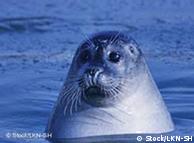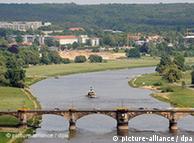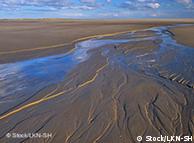文化社会 | 2009.06.26
德累斯顿易北河谷痛失“世界文化遗产”称号
德累斯顿的易北河谷失去了世界文化遗产的称号。在长达5年的时间里,易北河岸绵延20公里的当地自然景观曾享有世界文化遗产的美名。德累斯 顿最杰出的建筑之一是皮尔尼茨宫,原始的大自然与数百年间不断建造的建筑杰作相映成辉。德累斯顿的易北河谷从皮尔尼茨宫开始,沿易北河顺势而下,河上架有 钢架大桥,沿岸是巴罗克风格的老城区,直至历史久远的奥斯特葛黑葛城区。2004年,联合国教科文组织授予该地段德累斯顿世界文化遗产称号,2006年却 被列入该组织委员会的红色警告名单。该委员会坚信,计划在易北河上建造森林宫殿大桥将破坏易北河谷的自然景观,使其失去其独一无二的特点和总体价值。
在相关的争执中,德累斯顿早已成为输家。建桥之争使德累斯顿一分为二,一方是赞同者,另一方则是坚决的反对派。赞同方认为,桥梁起到了连接的作用, 他们在此所指的大多是交通基础设施,通过在易北河上搭建大桥有助于改善交通基础设施建设。赞同方表示,他们与反对方早已中断了联系,不再对话。反对方也持 同样的立场。而支持建桥的人往往被指责缺乏对天人合一理念的理解,这样的人是不会给德累斯顿带来好处的。另外,因建桥之争也形成了不同的政治阵营,同样涉 及到其他议题,有时甚至会对具体的工作造成影响。
冲突双方早已失去了达成妥协的意愿,这也影响到与联合国教科文组织的关系。德累斯顿迟迟不能理解,应向联合国教科文组织中心进行咨询,并且将他们的 意见考虑在内。莱茵兰-普法尔茨莱茵河谷中游文化遗产区的地方政府就聪明得多,早在建造桥梁或是隧道的筹划酝酿阶段,人们就将联合国教科文组织的决定纳入 考虑之中,与此同时却拒绝作任何对本地区不利的事情。德累斯顿的行动过于迟缓,该城将拥有一座新建大桥,但却失去了世界文化遗产的地位。
就这样永不复得吗?联合国教科文组织委员会表示,德累斯顿应重新提出申请。但无论哪个地段有资格提出申请,能否获此殊荣,建桥之争都将留下痕迹,而 并非所有的创伤都能愈合。建桥冲突双方应意识到,在德累斯顿有许多重要议题,亟待人们为此达成妥协,而不是展开永无休止的阵地战。
作者:Karsten Wolf/祝红
责编:乐然
Environment | 26.06.2009
Germany's Wadden Sea mudflats named world heritage site
Germany and the Netherlands registered the Wadden Sea, a tidal wetlands area on their northern coasts, as a contender for the UNESCO World Heritage title at the beginning of 2008. Friday's announcement makes the nature reserve the first one in Germany to be awarded the status.
Recently, the Wadden Sea has been under threat due to the constant flow of shipping traffic and plans for oil and gas drilling. There is also concern about the effect climate change could have on the area.
Visited by thousands of tourists every year, the Wadden Sea spans more than 10,000 kilometers and borders three countries in total: the Netherlands, Germany, and Denmark. Visitors flock there year-round to enjoy the endless expanse of shallow mud flats, caught between land and sea, and its diverse wildlife.
Under protection
In 1985, Germany officially declared the Wadden Sea tidal flats a nature reserve and national park. Parts of it have also been protected under national park status in the Netherlands.
Environmentalists fear for the Wadden Sea's future though as plans to deepen the Elbe River, which borders the Wadden Sea, to accomodate ships en route to the Hamburg Harbor could have a damaging effect on the nature reserve. Many different species make their home there, including seals, and an estimated 1.5 million birds descend on the Wadden Sea for food during migratory seasons.
 Bildunterschrift: Großansicht des Bildes mit der Bildunterschrift: The Wadden Sea is home to many different species
Bildunterschrift: Großansicht des Bildes mit der Bildunterschrift: The Wadden Sea is home to many different species
There has also been concern about the oil and gas drilling platforms planted in the middle of the park. In the German state of Schleswig-Holstein, it is legal to drill for oil in national parks, however, it goes against the rules of the UNESCO World Heritage committee. In order to get around a potential barrier to receiving the title, Germany and the Netherlands cut out the sections of the park used for drilling in their application.
There are also long-term concerns about the effect climate change will have on the wetlands, as rising sea levels could cause the area to slowly erode over time.
A UNESCO World Heritage title is the highest honor yet for the Wadden Sea and advocates say it will help to ensure its conservation.
Germany boasts a long list of UNESCO World Heritage sites in addition to the Wadden Sea, including the Hanseatic city of Lübeck, the Dome of Cologne, and the Messel pit, where the majority of fossils in the world have been found. The UNESCO World Heritage Committee will announce their final decision on all new entries by the end of the conference on June 30th.
vj dpa/AFP/kna
Editor: Trinity Hartman


沒有留言:
張貼留言